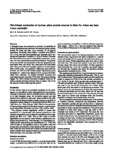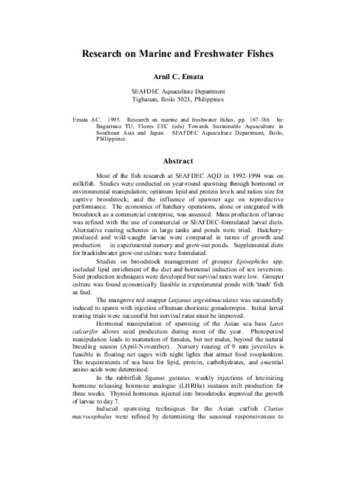Nutritional evaluation of various plant protein sources in diets for Asian sea bass Lates calcarifer
- Global styles
- MLA
- Vancouver
- Elsevier - Harvard
- APA
- Help

ดู/เปิด
วันที่
2000Page views
5,224ASFA keyword
AGROVOC keyword
Taxonomic term
เมตาดาต้า
แสดงระเบียนรายการเต็มCited times in Scopus
37 readers on Mendeley
- Citations
- CrossRef - Citation Indexes: 13
- Policy Citation - Policy Citations: 3
- Scopus - Citation Indexes: 18
- Captures
- Mendeley - Readers: 38
Share
นามธรรม
A biological assay was conducted to evaluate the suitability of various leguminous seed meals and leaf meals as dietary protein sources for Asian sea bass, Lates calcarifer. In the growth experiment, fish (initial mean weight ± standard error (SE) of 3.8 ± 0.5 g) were fed isonitrogenous and isocaloric diets containing test ingredients to replace 13–18% of the diet. The same diet formulations were used in a digestibility experiment, except that 1% Cr2O3 was added as an external indicator. The growth of the control fish was comparable to fish fed leguminous seed meal-based diets, and better than those given leaf meal-based diets. The control diet had the highest apparent protein digestibility (APD) value. No significant differences were observed between the APD of white cowpea (Vigna unguiculata), green mungbean (V. radiata) and papaya (Carica papaya) leaf meal-based diets. However, the cassava (Manihot esculenta) leaf meal-based diet had the lowest APD value. The present findings suggest that white cowpea and green mungbean meals can be used as protein sources in practical diets to replace 18% of the sea bass diet without affecting their growth.
การอ้างอิง
Eusebio, P. S., & Coloso, R. M. (2000). Nutritional evaluation of various plant protein sources in diets for Asian sea bass Lates calcarifer. Journal of Applied Ichthyology , 16(2), 56-60. https://doi.org/10.1046/j.1439-0426.2000.00160.x
Type
ArticleISSN
0175-8659คอลเลกชัน
- Journal Articles [1249]
Related items
Showing items related by title, author, creator and subject.
-
Research on marine and freshwater fishes
Emata, Arnil C. (Aquaculture Department, Southeast Asian Fisheries Development Center, 1995)Most of the fish research at SEAFDEC AQD in 1992-1994 was on milkfish. Studies were conducted on year-round spawning through hormonal or environmental manipulation; optimum lipid and protein levels and ration size for ... -
Proceedings of the Seminar-Workshop on Aquaculture Development in Southeast Asia and Prospects for Seafarming and Searanching, 19-23 August 1991, Iloilo City, Philippines
Lacanilao, F.; Coloso, Relicardo M.; Quinitio, Gerald F. (Aquaculture Department, Southeast Asian Fisheries Development Center, 1994)Documents the presentations at ADSEA '91, the 2nd Seminar-Workshop on Aquaculture Development in Southeast Asia. ADSEA '91 includes reviews of the status of the researches conducted by Southeast Asian Fisheries Development ... -
Nursery and grow-out culture of high-value fish species in sea cages
Gaitan, Albert G.; Toledo, Joebert D. (Aquaculture Department, Southeast Asian Fisheries Development Center, 2009)






